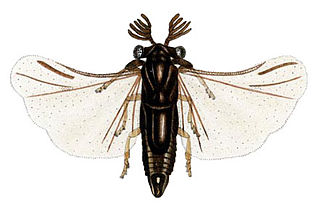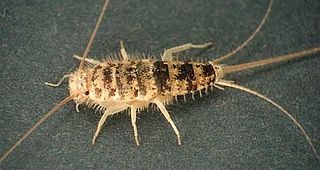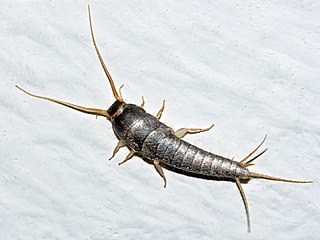
The ovipositor is a tube-like organ used by some animals, especially insects, for the laying of eggs. In insects, an ovipositor consists of a maximum of three pairs of appendages. The details and morphology of the ovipositor vary, but typically its form is adapted to functions such as preparing a place for the egg, transmitting the egg, and then placing it properly. For most insects, the organ is used merely to attach the egg to some surface, but for many parasitic species, it is a piercing organ as well.

The Strepsiptera are an order of insects with eleven extant families that include about 600 described species. They are endoparasites in other insects, such as bees, wasps, leafhoppers, silverfish, and cockroaches. Females of most species never emerge from the host after entering its body, finally dying inside it. The early-stage larvae do emerge because they must find an unoccupied living host, and the short-lived males must emerge to seek a receptive female in her host. They are believed to be most closely related to beetles, from which they diverged 300–350 million years ago, but do not appear in the fossil record until the mid-Cretaceous around 100 million years ago.

The Antofagasta Region is one of Chile's sixteen first-order administrative divisions. The second-largest region of Chile in area, it comprises three provinces, Antofagasta, El Loa and Tocopilla. It is bordered to the north by Tarapacá, by Atacama to the south, and to the east by Bolivia and Argentina. The region's capital is the port city of Antofagasta; another one of its important cities is Calama. The region's main economic activity is copper mining in its giant inland porphyry copper systems.

The guanaco is a camelid native to South America, closely related to the llama. Guanacos are one of two wild South American camelids, the other being the vicuña, which lives at higher elevations.

The Archaeognatha are an order of apterygotes, known by various common names such as jumping bristletails. Among extant insect taxa they are some of the most evolutionarily primitive; they appeared in the Middle Devonian period at about the same time as the arachnids. Specimens that closely resemble extant species have been found as both body and trace fossils in strata from the remainder of the Paleozoic Era and more recent periods. For historical reasons an alternative name for the order is Microcoryphia.

The Peloridiidae or moss bugs are a family of true bugs, comprising eighteen genera and thirty-four species. They are small, ranging in length from 2 to 4 mm, rarely seen, peculiarly lumpy, flattened bugs found in Patagonia, New Zealand, eastern Australia, Lord Howe Island, and New Caledonia. Peloridiids are found amongst mosses and liverworts, commonly in association with southern beech forests. They have become known as moss bugs for their habit of feeding on mosses. Almost all Peloridiidae species are flightless, except one. Their present distribution suggests they have existed since before the breakup of Gondwana. They are the only living members of the suborder Coleorrhyncha, which first appeared in the Upper Permian, over 250 million years ago.

The Machilidae are a family of insects belonging to the order Archaeognatha. There are around 250 described species worldwide. These insects are wingless, elongated and more or less cylindrical with a distinctive humped thorax and covered with tiny, close-fitting scales. The colour is usually grey or brown, sometimes intricately patterned. There are three "tails" at the rear of the abdomen: two cerci and a long central epiproct. They have large compound eyes, often meeting at a central point. They resemble the silverfish and the firebrat, which are from a different order, Zygentoma.

Zygentoma are an order in the class Insecta, and consist of about 550 known species. The Zygentoma include the so-called silverfish or fishmoths, and the firebrats. A conspicuous feature of the order are the three long caudal filaments. The two lateral filaments are cerci, and the medial one is an epiproct or appendix dorsalis. In this they resemble the Archaeognatha, although the cerci of Zygentoma, unlike in the latter order, are nearly as long as the epiproct.

Ctenolepisma is a genus of primitive insects in the order Zygentoma, closely related to the silverfish and firebrat but less reliant on human habitation, some species being found both indoors and outdoors and some found exclusively outdoors. The genus is distributed nearly worldwide in warm regions. Australia lacks native Ctenolepisma, but is home to introduced species.

The silverfish is a species of small, primitive, wingless insect in the order Zygentoma. Its common name derives from the insect's silvery light grey colour, combined with the fish-like appearance of its movements. The scientific name indicates that the silverfish's diet consists of carbohydrates such as sugar or starches. While the common name silverfish is used throughout the global literature to refer to various species of Zygentoma, the Entomological Society of America restricts use of the term solely for Lepisma saccharinum.

The Atacama Desert is a desert plateau in South America covering a 1,600 km (990 mi) strip of land on the Pacific coast, west of the Andes Mountains. The Atacama Desert is the driest nonpolar desert in the world, and the second driest overall, just behind some very specific spots within the McMurdo Dry Valleys as well as the only hot true desert to receive less precipitation than the polar deserts, and the largest fog desert in the world. Both regions have been used as experimentation sites on Earth for Mars expedition simulations. The Atacama Desert occupies 105,000 km2 (41,000 sq mi), or 128,000 km2 (49,000 sq mi) if the barren lower slopes of the Andes are included. Most of the desert is composed of stony terrain, salt lakes (salares), sand, and felsic lava that flows towards the Andes.

Coleorrhyncha or Peloridiomorpha, also known as moss bugs or beetle bugs, are a suborder of Hemiptera and represent an ancient lineage of moss-feeding insects. They show some similarities to the Heteroptera but have been considered distinct. It has a single extant family, the Peloridiidae. They are 2 to 5 millimetres in length, and feed on moss and liverworts. They have wings in some species which are reduced in others but all species are flightless and live in damp moss habitats and are associated with the distribution of Nothofagus trees in Australia, New Zealand, New Caledonia, and South America, which all were formerly part of the supercontinent Gondwana.

The Diplodactylidae are a family in the suborder Gekkota (geckos), with over 150 species in 25 genera. These geckos occur in Australia, New Zealand, and New Caledonia. Diplodactylids are the most ecologically diverse and widespread family of geckos in both Australia and New Caledonia, and are the only family of geckos found in New Zealand. Three diplodactylid genera have recently been split into multiple new genera.

Lomas, also called fog oases and mist oases, are areas of fog-watered vegetation in the coastal desert of Peru and northern Chile. About 100 lomas near the Pacific Ocean are identified between 5°S and 30°S latitude, a north–south distance of about 2,800 kilometres (1,700 mi). Lomas range in size from a small vegetated area to more than 40,000 hectares and their flora includes many endemic species. Apart from river valleys and the lomas the coastal desert is almost without vegetation. Scholars have described individual lomas as "an island of vegetation in a virtual ocean of desert."
Trinemophora is a genus of silverfish in the family Protrinemuridae. Four species are currently known, two of them being Trinemophora schaefferi(Silvestri, 1905) from Chile and Trinemophora bitschiana(Wygodzinsky, 1959) from Turkey.

Lepidotrix is an extinct genus of wingless insect belonging to Zygentoma in the family Lepidotrichidae. There is one described species in Lepidotrix, L. piliferum/pillifera. It is known from specimens found in Eocene aged Baltic amber and Rovno amber. The genus lacks occelli. Its relationship with the extant genus Tricholepidion, which has historically been placed in the same family, is disputed, with some studies finding the two taxa to not be closely related, with Tricholepidion being placed in its own family instead. While often spelled Lepidothrix in historic literature, this is homonymous with a genus of birds, and Lepidotrix was the spelling used in the original publication.

Tricholepidion is a genus of wingless insect belonging to Zygentoma, with only a single described species T. gertschi, native to the northern coast of California in Western North America. It lives under dead bark and in rotting wood of conifers in mesophytic forests. It is alternatively considered the only living member of the family Lepidotrichidae, which also includes Lepidotrix from Eocene aged European amber, or the only member of the family Tricholepidiidae. The taxonomic position of Tricholepidion is uncertain, in some molecular phylogenetics studies it has been recovered as less closely related to flying insects (Pterygota) than the rest of Zygentoma is, rendering Zygentoma paraphyletic. Each compound eye contains ~40 ommatidia, and they have three ocelli. Scales on the body are absent. Unlike Archaeognatha and the other families of Zygentoma, which have three- and sometimes two-segmented tarsi, they have five-segmented tarsi like many winged insects.
Thermobia aegyptiaca is a species of silverfish in the family Lepismatidae. The species was described by Hippolyte Lucas in 1840 based on specimens collected in Egypt. Thermobia aegyptiaca is distributed in Africa and the eastern Mediterranean Basin.

Ctenolepisma longicaudatum, generally known as the gray silverfish, long-tailed silverfish or paper silverfish, is a species of Zygentoma in the family Lepismatidae. It was described by the German entomologist Karl Leopold Escherich in 1905 based on specimens collected in South Africa, but is found worldwide as synanthrope in human housings.
Promops davisoni is a species of free-tailed bat in the family Molossidae. It was first described by Oldfield Thomas in 1921. While thought of as a subspecies of the big crested mastiff bat by scientists from roughly 1966 to 2010, morphological and geographical differences between P. davisoni and P. centralis are sufficiently suggestive of another species. P. davisoni is small for its genus, with a forearm length of 47.6 to 52.0 millimetres, and is light or cinnamon brown with distinguishable white bands on its back. P. davisoni is native to the Andes mountain range in Ecuador and Peru. More recently, evidence has been found that P. davisoni resides in the Atacama Desert in Chile.

















